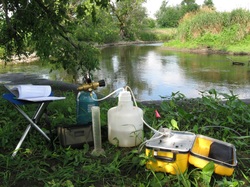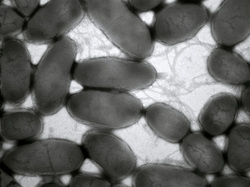Riparian Denitrification Research
 Dosing labeled nitrate to measure denitrification
Dosing labeled nitrate to measure denitrification
For my M.S. thesis (completed in 2013):
- I focused on understanding nitrogen dynamics in the groundwater in riparian areas, the portions of land directly adjacent to streams. These areas are potential hotspots for denitrification, a microbial process that turns soluble nitrate into gaseous dinitrogen or nitrous oxide. I aimed tease out some of the hydrologic and biogeochemical controls on where denitrification is occuring the most so that we can identify riparian areas that are more likely to provide this valuable ecosystem service.
- I utilized 15N labeled nitrate to measure denitrification in situ in riparian soils, and found that ground temperature and water residence time (as controlled by groundwater flux) were important controls on denitrification rates at this riparian site.
- Denitrification also accounted for a surprisingly low proportion of overall nitrate removal (5-12%) and it appears that dissimilatory nitrate reduction to ammonium (DNRA) is accounting for some of the remaining nitrate loss
- For the full journal publication on this work, go here
 Image of denitrifying bacteria (taken by Armanda Roco)
Image of denitrifying bacteria (taken by Armanda Roco)
Other research projects that have spurred off of this:
- We're examining interactions between nitrate and other electron acceptors with regards to denitrification. This project involves using electrodes to mimic iron reduction, coupled with in situ measurement of denitrification using soil chambers. This work was started with Helen Bergstrom (a summer undergraduate researcher from Brown U.) and is in collaboration with Elliot Friedman (Angenent Lab, Cornell).
- We're trying to better connect microbial dynamics with landscape observations of nitrous oxide emissions. This project includes measurement of denitrification in conjunction with quantification of nosZ genes that control nitrous oxide reduction, and is in collaboration with Armanda Roco (Shapleigh Lab, Cornell). Check out a video & poster related to this collaboration here.
